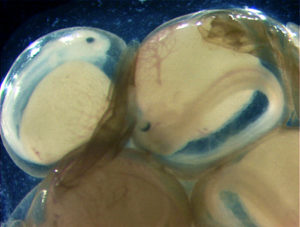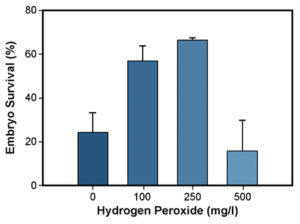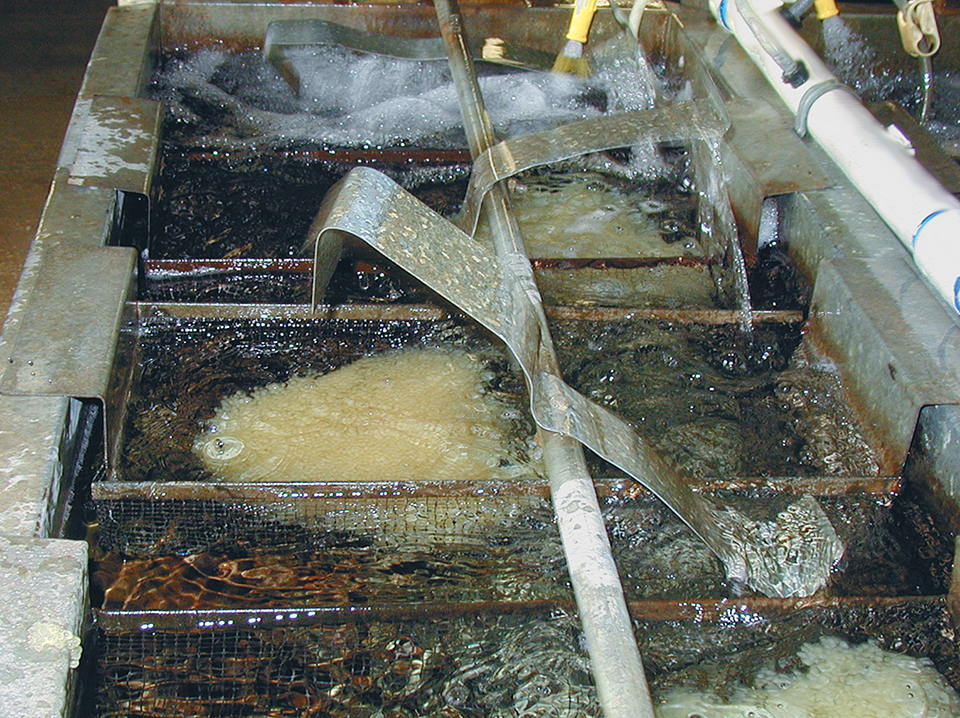Studies conducted at the Thad Cochran National Warmwater Aquaculture Center

Fungal and bacterial egg infections can be a significant problem for channel catfish hatcheries. Dead eggs and other organic matter in hatchery culture systems provide excellent substrates for fungi and bacteria. Without chemo-therapeutic treatment, these pathogens quickly overtake the egg mass and significantly reduce embryo survival.
Chemical therapeutants such as povidone iodine and formalin are often used to control potential infections. Povidone iodine is designated by the United States Food and Drug Administration (USFDA) as a low regulatory priority (LRP) aquaculture drug when used as an egg surface disinfectant, and formalin is approved by USFDA for the control of fungi of the family Saprolegniaceae on the eggs of all finfish.
Although formalin is an effective therapeutant, users share safety concerns due to its odor and suspected carcinogenicity. As an alternative, hydrogen peroxide is an effective egg disinfectant that significantly improves channel catfish embryo survival.
Treatment alternative
Hydrogen peroxide (H2O2) has been investigated as a treatment to control egg diseases for a number of fish species, and is currently designated by USFDA as an LRP aquaculture drug when administered at 250 to 500 milligrams per liter. Chemically, hydrogen peroxide is a powerful oxidizing agent that is relatively stable in its pure form. It is effective against many egg and fish pathogens, including fungi, bacteria, and ecto-parasites. Hydrogen peroxide is also environmentally friendly, since it decomposes into water and oxygen.
Recent studies at the Thad Cochran National Warmwater Aquaculture Center in Stoneville, Mississippi, USA, have demonstrated that hydrogen peroxide is an effective disinfectant for channel catfish eggs incubated in 26 degrees-C water.
Bath treatments

Channel catfish egg masses were collected, split into fourths, and placed into individual aquariums for bath treatment studies. Each portion was treated with hydrogen peroxide at a concentration of 0, 100, 250 or 500 milligrams per liter (active ingredient) every afternoon until embryonic eye pigmentation became apparent. During treatment, eggs were removed from the hatching tank and treated for 15 minutes in a static hydrogen peroxide bath, then returned to the tank.
When hatching was complete, embryo survival was calculated as the percentage of eggs hatched. The hatching success of channel catfish eggs was significantly improved with the 250 milligrams per liter treatment (Fig. 1). At a hydrogen peroxide concentration of 500 milligrams per liter, chorionic deterioration caused embryos to be prematurely released into the water column and die.
Flush treatments
Egg incubation troughs commonly contain about 380 liters of water and average one complete water exchange in 45 to 60 minutes. In commercial hatcheries, a 15-minute therapeutic bath treatment can be a substantial risk, with millions of eggs lost in the event treatment time is not monitored closely.
As an alternative, the authors sought to identify a concentration of hydrogen peroxide that would provide a beneficial treatment in a continuous-flow situation.
In a study, eggs were treated with 0, 35, 70,100, 200 and 300 milligrams per liter daily until eyed. Hydrogen peroxide was added at the water inlet side of the trough. The 70 milligrams per liter treatment yielded the highest embryo survival, and premature hatching was observed in both the 200 and 300 milligrams per liter treatments.
The higher residence time resulting from the flush treatment methodology yielded a lower optimal treatment concentration of 70 milligrams per liter, compared to 250 milligrams per liter for the 15-minute bath. For this reason, it is import to consider water volume and flow rate when developing flush treatment protocols.
To calculate the volume of hydrogen peroxide needed to treat eggs in a 380-liter hatching trough while maintaining a constant flow of water through the trough, the following formula was used:

Higher survival
Although formalin is an effective bath treatment for controlling Saprolegnia infections on channel catfish eggs, treatment with hydrogen peroxide yielded higher embryo survival. Overall embryo survival was 26 to 40 percent higher when eggs were treated daily with hydrogen peroxide at 250 milligrams per liter as a 15-minute bath compared to daily 15-minute formalin baths at the recommended concentration of 1,600 milligrams per liter.
Temperature effect

Discrepancies in literature regarding hydrogen peroxide use as an egg disinfectant may be due in part to differences in water temperature. In a recent comparison, the effects of temperature on hydrogen peroxide efficacy were examined by incubating channel catfish eggs at 28 degrees-C and 24 degrees-C. Eggs at each temperature were treated with 0, 100, 250, 500, and 1,000 milligrams per liter hydrogen peroxide as a daily 15-minute bath.
At 28 degrees-C, embryo survival was the highest when treated with 100 milligrams per liter hydrogen peroxide. At 24 degrees-C, embryo survival improved in the 500 milligrams per liter treatment. Together with earlier results that recommended a 250 milligrams per liter bath treatment at 26 degrees-C, these results showed that hydrogen peroxide activity increases with increasing water temperature.
Conclusion
The U.S. Food and Drug Administration has approved the use of hydrogen peroxide treatment to control infections on fish eggs at levels up to 500 milligrams per liter through a low-regulatory ruling. In a series of experiments, treatment with hydrogen peroxide at optimal concentrations demonstrated 30 percent higher embryo survival rates than those obtained with formalin. Considering 1.6 billion catfish fry are hatched annually in the United States, treatment of catfish eggs with hydrogen peroxide could potentially yield an increase of 480 million fry for the industry.
(Editor’s Note: This article was originally published in the August 2003 print edition of the Global Aquaculture Advocate.)
Now that you've finished reading the article ...
… we hope you’ll consider supporting our mission to document the evolution of the global aquaculture industry and share our vast network of contributors’ expansive knowledge every week.
By becoming a Global Seafood Alliance member, you’re ensuring that all of the pre-competitive work we do through member benefits, resources and events can continue. Individual membership costs just $50 a year. GSA individual and corporate members receive complimentary access to a series of GOAL virtual events beginning in April. Join now.
Not a GSA member? Join us.
Author
-
Brian C. Small, Ph.D.
United States Department of Agriculture
ARS Catfish Genetics Research Unit
Thad Cochran National Warmwater Aquaculture Center
141 Experiment Station Road
Stoneville, Mississippi 38776 USA
Tagged With
Related Posts

Health & Welfare
Advances in fish hatchery management
Advances in fish hatchery management – particularly in the areas of brood management and induced spawning – have helped establish aquaculture for multiple species.

Health & Welfare
Evaluating hybrid catfish egg quality
A significant correlation was established between ovarian fluid pH of stripped eggs and subsequent hatch of hybrid catfish eggs.

Health & Welfare
Genome editing potential to improve aquaculture breeding, production, Part 2
Genome editing can contribute to sustainable aquaculture production in terms of disease resistance and sterility to prevent interbreeding with wild stocks.

Health & Welfare
Genome editing: Potential to improve aquaculture breeding, production, Part 1
Due to high fecundity and external fertilization, most aquaculture species are amenable to genetic improvement technologies, including genome editing.


